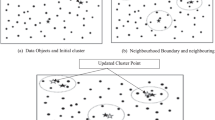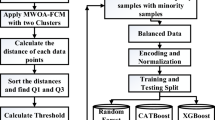Abstract
A method for screening of company workplaces with high ergonomic risk is developed. For clustering of company workplaces a fuzzy modification of bat algorithm is proposed. Using data gathered by a checklist from workplaces, information for ergonomic related health risks is extracted. Three clusters of workplaces with low, moderate and high ergonomic risk are determined. Using these clusters, workplaces with moderate and high ergonomic risk levels are screened and relevant solutions are proposed. By a case study this method is illustrated and validated. Important advantages of the method are reduction of computational effort and fast screening of workplaces with major ergonomic problems within a company.
Access this chapter
Tax calculation will be finalised at checkout
Purchases are for personal use only
Preview
Unable to display preview. Download preview PDF.
Similar content being viewed by others
References
Aci, M., Avci, M.: K nearest neighbor reinforced expectation maximization method. Expert Systems with Applications 38(10), 12585–12591 (2011)
Arwini, K., Dodson, J.T.C.: Information Geometry: Near Randomness and Near Independence. Springer, Heidelberg (2008)
Levy, B., et al.: Occupational and Environmental Health: Recognizing and Preventing Disease. Oxford University Press, Oxford (2011)
Barthelemy, J., Brucker, F.: NP-hard Approximation Problems in Overlapping Clustering. Journal of classification 18(21), 59–183 (2001)
Forgy, E.W.: Cluster analysis of multivariate data: efficiency versus interpretability of classifications. Biometrics 21, 768–769 (1965)
Gower, J.C.: Properties of Euclidean and non-Euclidean distance matrices. Linear Algebra and its Applications 67, 81–97 (1985)
Bezdek, J.C.: Numerical taxonomy with fuzzy sets. Journal of Mathematical Biology 1, 57–71 (1984)
Bezdek, J.C., Ehrlich, R., Full, W.: FCM: The fuzzy c-means clustering algorithm. Computers & Geosciences 10, 191–203 (1984)
Li, H., Li, J., Kang, F.: Risk analysis of dam based on artificial bee colony algorithm with fuzzy c-means clustering. Canadian Journal of Civil Engineering 38(5), 483–492 (2011)
Lorenzo, J., Mendez, J., Castrillon, M., Hernandez, D.: Short-term wind power forecast based on cluster analysis and artificial neural networks. Advances in Computational Intelligence 6691(1), 191–198 (2011)
Lundgren, E.R., McMakin, H.A.: Risk communication: a handbook for communicating environmental, safety, and health risks, vol. 1, pp. 1–7 (2009)
Paterlini, S., Minerva, T.: Evolutionary approaches for cluster analysis. Soft Computing Applications, 167–178 (2003)
Runkler, A.T.: Ant colony optimization of clustering models. International Journal of Intelligent Systems 20(12), 1233–1251 (2005)
Yang, X.-S.: A New Metaheuristic Bat-Inspired Algorithm. In: Yang, X.-S. (ed.) Nature Inspired Cooperative Strategies for Optimization (NICSO). Studies in Computational Intelligence, vol. 284, pp. 65–74 (2010)
Li, X.Y., et al.: Fuzzy clustering algorithm based on improved particle swarm optimization and its application. Journal of Applied Mechanics and Materials, 44–47 (2010)
Yoshida, T., Okatani, K.: A graph-based projection approach for semi-supervised clustering. In: Kang, B.-H., Richards, D. (eds.) PKAW 2010. LNCS, vol. 6232, pp. 1–13. Springer, Heidelberg (2010)
Author information
Authors and Affiliations
Editor information
Editors and Affiliations
Rights and permissions
Copyright information
© 2011 Springer-Verlag Berlin Heidelberg
About this paper
Cite this paper
Khan, K., Nikov, A., Sahai, A. (2011). A Fuzzy Bat Clustering Method for Ergonomic Screening of Office Workplaces. In: Dicheva, D., Markov, Z., Stefanova, E. (eds) Third International Conference on Software, Services and Semantic Technologies S3T 2011. Advances in Intelligent and Soft Computing, vol 101. Springer, Berlin, Heidelberg. https://doi.org/10.1007/978-3-642-23163-6_9
Download citation
DOI: https://doi.org/10.1007/978-3-642-23163-6_9
Publisher Name: Springer, Berlin, Heidelberg
Print ISBN: 978-3-642-23162-9
Online ISBN: 978-3-642-23163-6
eBook Packages: EngineeringEngineering (R0)




